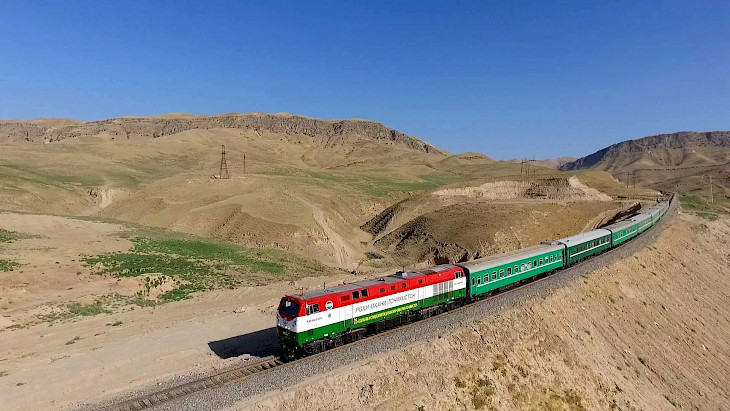Tajikistan, aiming to strengthen its position in the regional transport network, is resuming a large-scale railway project connecting Tajikistan, Afghanistan, and Turkmenistan (TAT).
This project, initially conceived in 2013, has gained new momentum thanks to the support of South Korea, Nezavisimaya Gazeta newspaper wrote.
History of the First Trans-Afghan Railway Corridor
Construction of the first trans-Afghan railway corridor Turkmenistan-Afghanistan-Tajikistan (TAT) began on June 5, 2013, in the Turkmen city of Atamyrat, located 85 km from the Afghan border.
The presidents of Afghanistan, Hamid Karzai, Turkmenistan, Gurbanguly Berdimuhamedov, and Tajikistan, Emomali Rahmon, were present to lay the first track, embedding a capsule with a message for future generations.
However, due to economic and political reasons, the project was later frozen.
Tajikistan-Korea Cooperation – A New Impetus for the Transport Route
The Ministry of Transport of Tajikistan signed an agreement with the Korea International Cooperation Agency to develop the feasibility study (FS) for the Jaloliddini Balkhi-Nizhniy Pyanj railway section.
The cost of the FS development is $4 million, demonstrating the seriousness of both parties' intentions.
The project involves the construction of a 51-kilometer railway line in Tajikistan, extending to the Afghan border.
Special attention is being paid to creating reliable infrastructure, including the construction of 28 railway bridges to ensure uninterrupted communication between the two countries. The project is expected to take three years, and its completion promises to be a significant event for the region's transport system.
Maintaining the standard gauge of 1,520 mm, typical for the post-Soviet space and Afghanistan, the new railway will enable efficient cargo transit without the need for additional transshipment or wheelset changes. This solution will significantly enhance the economic efficiency of transportation and make the route more attractive to shippers.
Experts note that the project's potential return could surpass the development of railway connections in the North-South corridor. Despite TAT's cargo potential being less than the North-South direction, the unified gauge will ensure more economical operations, guaranteeing the project high profitability in the long term.
As Maria Nikitina, a transport logistics expert, pointed out: "This initiative is not only economically beneficial but also likely aligned with the Russian Federation. Moreover, it's possible that the United States will welcome the project's implementation with South Korea's participation, hoping for a share in this promising enterprise."
The project's revival also signals potential shifts in Tajikistan's foreign policy course concerning Afghanistan.
Despite Tajikistan's President Emomali Rahmon not officially recognizing the Taliban government that came to power in Kabul in August 2021, economic realities are forcing the country to seek avenues for cooperation.
How the TAT Project Idea Emerged
The idea for this project initially arose during tense relations between Tajikistan and Uzbekistan when Tashkent used railway blockades as an economic pressure tool against Dushanbe.
In search of alternative routes, Tajikistan found support from Kabul and Ashgabat, and by the end of 2018, construction was planned to be completed. However, improving relations between Tashkent and Dushanbe shifted Tajikistan's priorities, leading to the project's postponement.
Sardar Aytakov, an expert on Central Asia, notes the diplomatic complexities that arose from the project's suspension: "Tajik authorities were not particularly diplomatic in their refusal to implement this project. In September 2018, the Tajik ambassador to Uzbekistan publicly announced the suspension of the TAT project, citing the improvement of relations between Uzbekistan and Tajikistan. This statement puzzled the Turkmen side and led to a cooling of interstate relations."
Relations between Tajikistan and Turkmenistan began to improve only in 2021 after Emomali Rahmon's visit to Turkmenistan.
However, the issue of constructing the TAT railway remained unresolved, which continued to affect bilateral relations.
Russian expert on Afghanistan Alexander Knyazev highlights the potential significance of the TAT project in the broader context of regional transport infrastructure: "When combined with the Trans-Afghan railway project Termez–Naibabad–Logar–Kharlachi, which is intended to provide access to the Pakistani ports of Karachi and Gwadar, the Tajikistan–Afghanistan–Turkmenistan project may acquire new strategic importance. If we also consider the possibility of implementing Turkmenistan's project to build the Turgundi–Herat–Khaf railway, with access to the Iranian ports of Chabahar and Bandar Abbas, Tajikistan could significantly improve its transport position in the future."
However, the expert warns that without integration with other transport projects within Afghanistan, the significance of the Jaloliddini Balkhi–Nizhniy Pyanj section will be limited. He also emphasizes the need to renegotiate the route of the railway across Afghan territory with the new authorities in Kabul.
The revival of the TAT project opens up new prospects for economic development and regional integration in Central Asia.
However, its successful implementation will require careful diplomatic work, technical expertise, and long-term vision. Tajikistan is on the brink of making important decisions that could significantly impact its role in the regional transport network and its economic well-being.
CentralasianLIGHT.org
August 8, 2024

